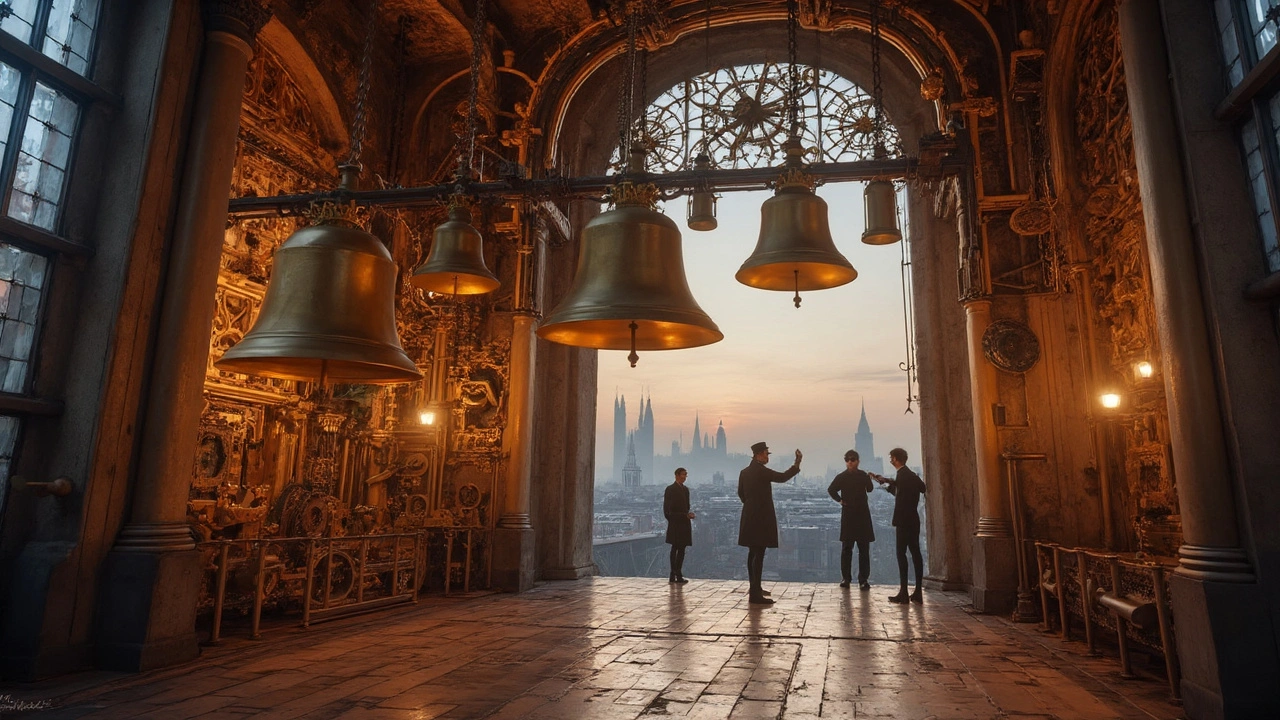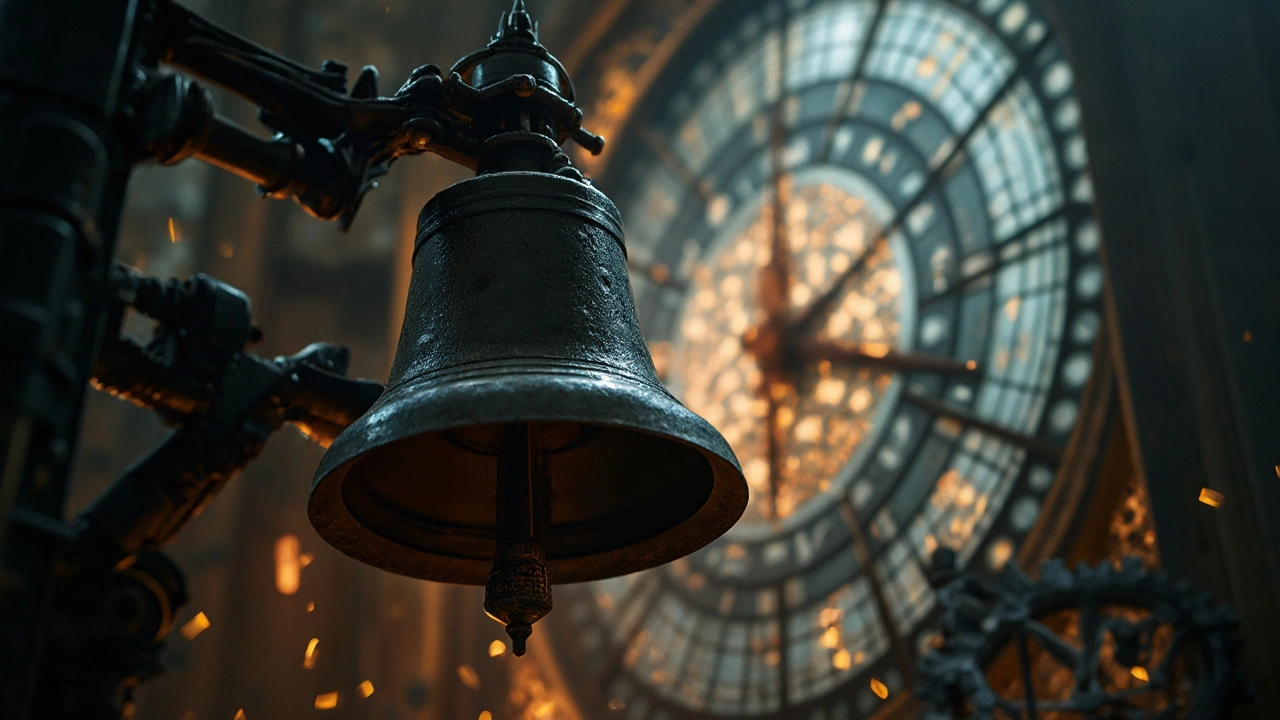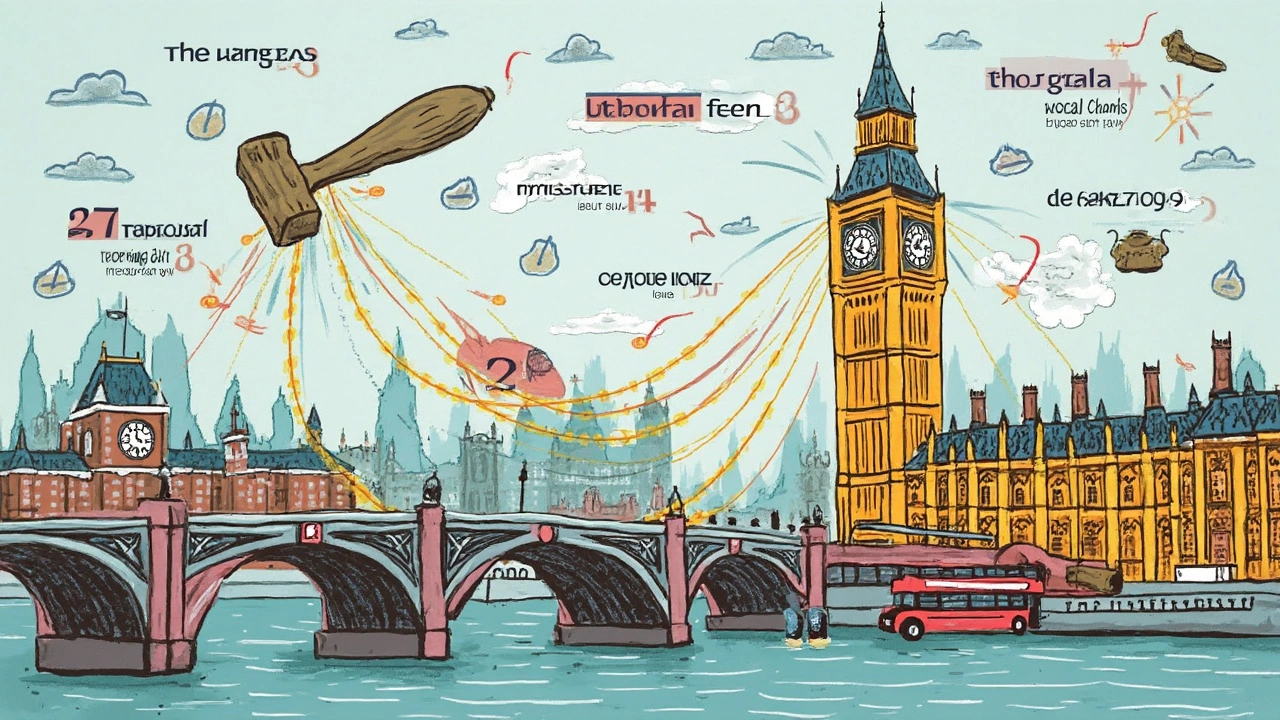The Sounds of Big Ben: How the Chimes Are Created

Big Ben’s chimes are more than just a way to tell the hour—they’re a sound recognized around the world. Most people picture one big bell inside the clock tower, but the truth is, there are five bells behind those legendary tones. The biggest one—Big Ben itself—handles the hourly booms, while four smaller bells play short musical phrases, known as the Westminster Quarters, every 15 minutes.
People often ask, what makes Big Ben’s sound so unique? It’s all in the details: the size and shape of the bells, how the hammers strike them, and the quirky history of how the bells were cast. There’s even a ‘wrong’ note in the chime, and it’s been that way for over 160 years. Curious about how all these parts come together to create that classic sound you hear on New Year’s Eve or royal occasions? You’re in the right place. We’ll break down what happens behind the scenes, why some engineers call the bells a happy accident, and how you can catch the chimes at their clearest if you’re ever in London.
- How Big Ben's Chimes Work
- The Bells and Their Features
- The Clock Mechanism Behind the Sound
- Famous Quirks and Fun Facts
- Tips for Hearing the Chimes Yourself
How Big Ben's Chimes Work
If you’ve ever listened closely to the Big Ben chimes, you might notice there’s more to them than just one booming bell. The famous sound is actually a clever mix played by five bells at the top of the clock tower. The largest bell, which most folks call Big Ben (but its official name is the Great Bell), marks every hour with its deep tone. The other four bells handle the fancy bit—the 'Westminster Quarters' tune that rings every 15 minutes. This is that catchy melody you’ll hear in movies, TV shows, even at New Year’s Eve broadcast from London.
So, how does it all line up so perfectly? It’s actually a dance between moving parts. The clock mechanism triggers a set of hammers. These hammers swing out, hitting the bells in a specific order and rhythm. The Westminster Quarters use a simple pattern, but each quarter has a unique combination of notes to cue listeners on the time.
- Quarter past: First phrase of the tune (5 notes)
- Half past: Second and first phrases back-to-back (10 notes)
- Quarter to: Third, second, and first phrases (15 notes)
- On the hour: All four phrases, then the Great Bell chimes out the hour count
What’s wild is that this entire routine runs like clockwork (literally!)—once wound, the mechanical system doesn’t need computer software or even electricity to keep those chimes going. There’s even a 13-foot-long pendulum, and engineers make tiny adjustments using old pennies to guarantee accuracy. A study from the UK Parliament says the mechanism’s timing is accurate to within two seconds a week—pretty impressive for tech from the 1800s.
Here’s a snapshot of bell and hammer details for quick reference:
| Bell | Role | Weight (Approx.) |
|---|---|---|
| Great Bell (Big Ben) | Hour chimes | 13.5 tons |
| Quarter Bells (4 total) | Westminster Quarters melody | 1–4 tons each |
Because of this setup, the Big Ben chimes are one of the most reliable sounds in Westminster. People living near the tower actually set their watches by them, and radio stations still use a live microphone inside the tower, sending the sound all over the UK and the world.
The Bells and Their Features
When you think of Big Ben, you probably imagine a single bell. But there’s actually a whole family of bells inside the tower. The main one—the real Big Ben—weighs about 13.5 tons. It’s over 2 meters tall and has a diameter of nearly 2.7 meters. This monster bell does the 'bong' sound every hour, and you’ll feel it in your chest if you’re anywhere close by.
Next to Big Ben are four smaller bells, which handle the chimes people hear every 15 minutes. Each of these bells has its own weight and note, which together create the tune known as the Westminster Quarters. Here's a quick breakdown of the bells, what they do, and their rough weights:
| Bell Name | Weight (tons) | Job |
|---|---|---|
| Big Ben | 13.5 | Hour strikes |
| Quarter Bell 1 | 1.1 | Westminster Chime |
| Quarter Bell 2 | 1.3 | Westminster Chime |
| Quarter Bell 3 | 1.0 | Westminster Chime |
| Quarter Bell 4 | 0.9 | Westminster Chime |
All five bells are made from cast bronze, a durable mix of copper and tin, designed to deliver that unmistakable sound year after year. During testing back in 1858, the original Big Ben actually cracked because the hammer was too heavy. Instead of melting it down, they just turned the bell a bit and used a lighter hammer. This fix gave Big Ben a unique, slightly sharp note—a mistake that’s now part of London’s soundscape.
Each quarter bell has a specific note, and together they play a four-part melody using different sequences at each quarter—15, 30, and 45 minutes. Only on the hour do you hear the famous deep Big Ben bong. If you listen closely, you’ll notice one note sounds a little off. That’s not your ears playing tricks on you—the smallest quarter bell was mistuned on purpose when it was first cast, so it fits with the others in harmony.
These bells aren’t struck inside the swinging bell like you’d see on a church tower. Instead, fixed hammers hit the outside of the bells, giving more control over the timing and volume, so those chimes are crisp and on cue for radio broadcasts. The bells also rest on a sturdy iron frame that helps keep vibrations and wear under control—important if you’re sounding off every 15 minutes, 24 hours a day.
Long story short, every bell inside Big Ben’s tower has a specific job, a story, and even a few quirks, all working together to create one of the world’s best-known sounds.

The Clock Mechanism Behind the Sound
The secret behind Big Ben's famous chimes isn’t just big bells. It’s a monster piece of Victorian engineering that powers the clock and times every strike to the second. At the heart of the tower sits a huge clock mechanism built in 1859 by clockmaker Frederick Dent. This isn’t your usual wind-up clock. We’re talking about gears, counterweights, and something called a double three-legged gravity escapement—rare outside this clock—which keeps everything ticking smoothly, even when London’s weather tries to mess things up.
The real trick? The chimes are controlled by a drum with set pins. Every 15 minutes, the mechanism pushes certain wires based on how the pins are set. These wires pull on levers that, in turn, lift hammers and then let them drop onto the bells at the exact right moment. When it’s time for the hour, a bigger lever readies the hammer for massive Big Ben itself.
- The entire mechanism weighs about five tons—more than most cars.
- The mechanism gets wound three times a week—by hand. If someone forgets, the clock stops.
- Pennies are actually placed on the huge pendulum for fine-tuning the time, speeding up or slowing down the whole thing by fractions of a second.
If you’re wondering how it stays so accurate: mechanical parts are cleaned and checked weekly. Even minor delays—say, from cold weather—are fixed by subtle tweaks. Engineers even use a coin (yes, a British penny) on the pendulum to shave off or add seconds. This dedication keeps the Big Ben chimes recognized for their near-perfect timekeeping for over 160 years.
| Feature | Details |
|---|---|
| Clock Weight | 5 tons |
| Pendulum Length | 4 meters (13 feet) |
| Chime Accuracy | Within 1 second |
| Number of Weekly Windings | 3 |
A big tip: if you want to hear the chimes when they're truly at their best, visit right after a maintenance session. The mechanism works at its smoothest and never misses a beat.
Famous Quirks and Fun Facts
Everybody’s heard Big Ben chime, but not everyone knows all the weird details behind the bells and the sounds. For starters, the famous "B" note in the chime is actually out of tune, and it has been ever since the bells rang for the first time back in 1859. The bell makers tried several times to get it right. After the main bell cracked, the repair job had to be done on the cheap, so they just shifted the hammer and carried on. That off-key note? It’s now a part of the tower’s charm and what gives it such a unique sound.
Now, here’s something that surprises most people: the main bell isn’t actually called Big Ben by officials. It’s officially the Great Bell. "Big Ben" is just a nickname, but it stuck because it's catchy. Also, TV and movies often use a sound effect to make Big Ben seem louder or more dramatic than it really is. If you’re nearby, the real thing is deep and powerful, but it doesn’t shake your bones like it might sound on screen.
Weather also plays a role in the chimes. On foggy or rainy nights, locals sometimes say they can hear Big Ben’s song from several miles out. The reason: moist air carries sound better. There are even urban legends about Londoners setting their watches by the echo rather than the original sound!
- The bells play over 700,000 chimes each year.
- BBC Radio started airing the chimes on New Year’s Eve in 1923, and they’re still doing it today.
- There’s a backup hammer for the main bell, just in case the usual one gives out.
| Fact | Details |
|---|---|
| Main Bell’s Weight | About 13.5 tons (13,760 kg) |
| First Chime | July 11, 1859 |
| Height of the Clock Tower | 96 meters (about 315 feet) |
| Bells Cast In | Whitechapel Bell Foundry |
If you’re hoping to spot something unusual, try timing your visit when the bells must be muted, like for maintenance. There’s always chatter in London when the clock tower goes silent—it only happens when absolutely necessary.

Tips for Hearing the Chimes Yourself
If you want to catch those famous Big Ben chimes in person, you’ve got more options than you might think. The clock tower—also called the Elizabeth Tower—sits at the north end of the Palace of Westminster. This spot is in central London, easy to reach by tube or bus. The most straightforward way: just walk over Westminster Bridge. On the bridge or right across from the tower on Parliament Square, the sound rings out loud and clear, especially at the top of the hour when Big Ben itself strikes.
The chimes happen every 15 minutes, but the biggest moment is at the full hour when the main bell sounds. Sunday mornings and late evenings (after rush hour) are usually quieter, which means fewer crowds and less city noise messing with the sound. Local tip: head there at midnight on New Year’s Eve for a seriously unforgettable vibe—the Big Ben chimes are a core part of London’s celebrations.
If you can’t make it right up to Westminster, you’re not out of luck. You can often hear the chimes from places like St. James’s Park or even Southbank, especially on still days when sound carries farther. Want to know how far the chimes travel? They can reach up to a mile away on a quiet day.
| Location | Approximate Distance from Big Ben | Chime Audibility |
|---|---|---|
| Westminster Bridge | 0.1 miles | Crystal clear |
| Parliament Square | 0.05 miles | Loud and clear |
| St. James's Park | 0.5 miles | Still impressive |
| Southbank | 0.7 miles | Best when city is quiet |
Access inside the Elizabeth Tower itself is limited to UK residents who arrange a tour through a Member of Parliament, and there’s a lot of competition for those spots. So, most folks just enjoy the bell sounds from outside. But don’t forget—BBC Radio 4 broadcasts the Westminster chimes live at 6pm and midnight London time. You don’t even need to be in London to enjoy them—just tune in online.
For tourists and locals alike, the old trick is patience. Sometimes London traffic or weather can drown out even the biggest bell. But get your timing right, pick a good spot, and you’ll hear the same notes that have echoed over the city since 1859. And honestly? There’s nothing like hearing it for real.